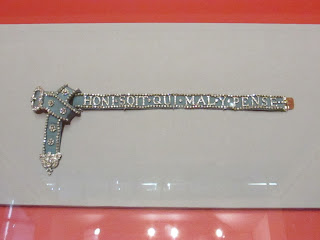John Singer Sargent - Portrait of Winifred, Duchess of Portland, 1902
Stylish swagger portraits in the Grand Manner publicly displaying the status and social aspirations of the sitters are the hallmark of this show, and Sargent (1856-1925) doesn't disappoint, executing these paintings with such self-assured bravura brushwork which I found to be very reminiscent of Spanish artist Joaquín Sorolla (1863-1923) here. Both were working at the same period and were equally adept at capturing the human form and describing a range lighting effects on both flesh and a range of fabric surface textures.
Sargent was born in Florence to American parents, trained in Paris, and greatly admired the paintings of Frans Hals and Diego Velázquez. Sargent was able to take advantage of the development of new chemical pigments in the late 19th century to create works in saturated colour.
This exhibition pairs certain portraits of socialites with the actual dresses or accessories that are depicted in the portraits. The exhibition also explains the extent to which Sargent personally styled his subjects, selecting the latest couture outfits from Paris for the subjects to be painted in, and then manipulating the dress by arranging and pinning the fabric until it suited his artistic ends. Sargent displays his artistic skills not only through his use of colour and composition, but also through his use of the chiaroscuro technique, contrasting areas of light and dark within the picture the better to highlight the sitters faces and hands, or enhance the sense of drama within the picture plane.
The haute couture dresses in their cases dotted about the exhibition appear almost like sculptures in themselves, standing proudly, unsupported by the frame of a human body. Many are created by the House of Worth one of the most notable fashion houses of the period, and created from sumptuous fabrics such as brocades or velvets, and have surfaces richly embellished with gold/silver embroidery or exquisite lace.
Madame X, Madame Pierre Gautreau, 1883-84
Mrs Fiske Warren (Gretchen Osgood) and Her Daughter Rachel, 1903
Miss Elsie Palmer, 1889-90
Portrait of Mrs Robert Harrison, 1886
Ena and Betty, Daughters of Asher and Mrs Wertheimer, 1901
Mrs Hugh Hammersley (1892)
Edouard Pailleron, 1879
Portrait of Winifred Duchess of Portland, 1902
Lady Helen Vincent, Viscountess D'Abernon, 1904
Colonel Ian Hamilton,
Mrs Carl Meyer and her Children (1896)

Portrait of Mrs Leopold Hirsch, 1902
Sargent and Fashion
until 7th July
Tate Britain
Millbank
London
SW1P





































































No comments:
Post a Comment